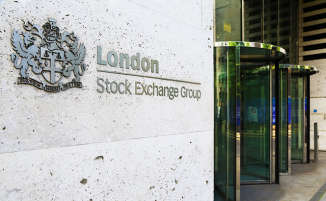Hogan Lovells has secured a new role as adviser to the UK government on the £3.6bn acquisition of International Distribution Services (IDS), the parent company of Royal Mail, by Czech billionaire Daniel Křetínský’s EP Group, alongside Kirkland, Paul Weiss, and Slaughter and May.
Cleary and White & Case switch on for Canal+ £2.5bn IPO in London
Elite US firms played a key role as French broadcaster Canal+ made its debut on the London Stock Exchange, becoming one of the first companies to list under the FCA’s new rules.
Odimba-Chapman succeeds Bates as Clifford Chance London managing partner
Clifford Chance has named employment partner Chinwe Odimba-Chapman as its new London managing partner, succeeding Michael Bates.
Stepping into the role as of 1 January, Odimba-Chapman (pictured) will be CC’s first black London managing partner. She currently serves as the firm’s global people and talent partner.
Bates, who is a Legal 500 Hall of Famer for corporate M&A, is stepping down at the end of this year after seven years in the post and moving back into a fee-earning role.
CC lifer Odimba-Chapman joined the firm in 2002 and became a partner in 2018. Her practice focuses on advising global clients on a wide range of employment law issues on a cross-border basis.
Global managing partner Charles Adams said: ‘I would like to congratulate Chinwe on her new role and would like to again thank Michael for successfully leading our UK business for seven years to its current strong and market-leading position.’
Odimba-Chapman has also been appointed as co-regional managing partner for the firm’s ‘One Europe’ region, alongside regional managing partner for continental Europe, Steve Jacoby.
Adams continued: ‘We know Europe like nobody else, with top experts in every key jurisdiction and proven strengths in working on the most complex cross-border mandates where we can have the biggest impact on our clients’ success.’
DACB to launch in New York and LA with hire of 30-strong team from pair of US firms
DAC Beachcroft is set to make a major step into the US market, recruiting a 30-strong group of lawyers from two firms to launch in New York and Los Angeles in January.
The firm is taking on four partners and 26 other lawyers and staff from insurance and reinsurance boutique Vogrin & Frimet and national firm Robinson+Cole.
Vogrin & Frimet is an eight-lawyer firm with offices in New York, Los Angeles and New Jersey, while Robinson+Cole is a much larger, full-service firm, with around 400 lawyers across nine US bases.
Name partners George Vogrin and Mike Frimet will join from Vogrin & Frimet with their six colleagues, while partners Lawrence Klein and Gilbert Lee will move over from Robinson+Cole, alongside 20 other lawyers and staff.
All four partners are primarily based in New York, but will spend time in California. Vogrin and Frimet specialise in insurance coverage and reinsurance matters, with particular experience representing global insurers in the London insurance market, while Klein and Lee are insurance coverage specialists, who both previously worked at Sedgwick, the US firm which closed in 2018.
In the short term, the bulk of the team will be based in New York, with the firm expecting to expand the Los Angeles office in future.
‘Continuing our international expansion is one of the key elements of our strategy,’ said David Pollitt, DACB’s managing partner (pictured).
‘Being able to establish operations in the thriving US legal market not only satisfies a key client demand within our insurance practice, but also gives potential for our clients across other areas of our business to benefit from our presence in the US market,’ he continued.
The move follows a series of international office openings for the firm. Over the past nine months, DACB has launched in Hong Kong and Peru, building on last year’s expansion into Milan, Rome, and Buenos Aires.
The firm does also have a representative office in Miami, which it opened in 2016 with the hire of business development manager Sascha Stullenberg from AIG. Since 2017, the firm has also been a member of the four-way Legalign Global alliance with three other insurance-focused law firms – Germany’s BLD Bach Langheid Dallmayr, US firm Wilson Elser, and Wotton Kearney in Australia.
DACB this year posted its tenth consecutive year of revenue growth, with a 9% increase in turnover to £326.5m. Profit before tax saw a 15% increase to £71m, while partner profits rose to £700,000, up 7% from last year’s £652,000.
Managing partner David Pollitt told LB earlier this year that the basis for the firm’s recent international strategy has been to ‘talking to clients about where they see growth and specific needs, and determining how we can support them in those areas’.
Doubling up: LB100 firms set 10% growth benchmark as more than half pull off double-digit hikes
More than half of the UK’s 100 largest law firms posted double-digit revenue increases for the last financial year, with the group bouncing back from a jittery 2022-23 to drive total turnover to a new high of £37bn.
Data collected for the latest LB100 – which spans firms from the now-£3bn DLA Piper to £40m City boutiques and regional practices – underlines what a strong year 2023-24 was for many UK law firms, despite lingering uncertainty after the previous financial year.
Following healthy 2023 results from the LB Global 100, which saw total revenues rise by more than 6%, the UK’s leading firms went even further, with an average revenue increase of 10% across the group, up from 8% last year.
Fifty-three of the 100 firms boosted turnover by a double-digit percentage – up from 34 last year – with more than 90% growing their top line, pushing combined revenues for the group from £33.8bn in 2022-23 to £37bn for the most recent financial year.
Slaughter and May corporate and M&A co-head Simon Nicholls attributed this bounceback to a recovery in transactional markets. ‘Deals were back after a lowkey 2023, and we were happy to see more than our fair share of activity. Alongside that, our disputes and antitrust practices motored on and had great years once again. We saw momentum build through the year in all key practice areas.’
Herbert Smith Freehills CEO Justin D’Agostino described 2023-24 as ‘an incredibly strong year’, while also acknowledging a point made in PwC’s recent law firm survey that the top 10 UK firms have been able to increase fees by 40% over the last five years.
‘Demand was up in every region and every practice group,’ he said. ‘There was a surge in class actions, competition disputes and transactional work. And for all firms there has also been a focus on pricing – a lot of markets have had inflationary pressures and firms have had to respond to that, which clients accept.’
The transatlantic DLA tops the table by revenue after breaking through the £3bn mark for the first time, a performance outgoing CEO Simon Levine attributed in large part to ‘standout practices focused on litigation and regulation’, as well as a more recent pickup in transactional activity.
‘You might expect some areas to have struggled, but while the transactional side was quieter, there was still plenty of activity in corporate, M&A, private equity and financing,’ said Levine, who is handing on the baton as international managing partner and global co-CEO to Charles Severs next year after a decade leading the firm.
The £3bn landmark for DLA was achieved through a 6% revenue increase, placing it slightly behind the average of 10% achieved by the group as a whole.
While double-digit growth was achieved by firms of all shapes and sizes, from the magic circle to regional players, the group that lagged slightly behind the 10% benchmark was firms with a large US footprint gained from transatlantic mergers – Eversheds Sutherland, Norton Rose Fulbright, Bryan Cave Leighton Paisner, DLA, Hogan Lovells and Womble Bond Dickinson.
Average revenue growth by firm category
| Firm category | Revenue growth |
|---|---|
| International firms | 11% |
| London-only firms | 11% |
| Magic circle | 11% |
| National firms | 10% |
| Regional firms | 12% |
| Transatlantic mergers | 6% |
The magic circle put in a more than respectable showing this year, with Freshfields leading the way with a 16% hike to £2.14bn. While Allen & Overy’s pre-merger revenue rise of 6% to £2.2bn was the slowest growth among that elite group, the firm will add around 30% to its top line next year with the addition of Shearman & Sterling.
There were also notably strong showings from London firms such as Kingsley Napley (17%), pensions boutique Sacker & Partners (25%) and Mishcon de Reya, which posted an 18% hike – the firm’s third consecutive year of double-digit growth – on the back of its January 2023 merger with Taylor Vinters.
‘It was a good year,’ managing partner James Libson told LB. ‘The things we wanted to achieve we achieved – the merger with Taylor Vinters was the first time we’ve ever done anything on that scale.
While many firms within the upper echelons of the LB100 are decisively looking to the US for growth, Mishcon achieved its recent successes without a presence in the States, where it closed a small New York base in 2020.
‘Obviously America is very important – we have a big client base there, and lots of people that do business there. But it’s an unbelievably well serviced market,’ Libson explained. ‘The US law firms are among our biggest allies and referrers – we do a lot of work in conjunction with them. It’s very difficult in America to establish a presence that’s meaningful in even any one area, let alone across areas.’
Top 10 LB100 firms by revenue growth
| Firm | Revenue growth |
|---|---|
| Fletchers Solicitors | 35% |
| Bond Turner | 33% |
| Burges Salmon | 27% |
| Veale Wasbrough Vizards | 26% |
| Sacker & Partners | 25% |
| Kennedys | 23% |
| Osborne Clarke | 21% |
| Birketts | 20% |
| Mishcon de Reya | 18% |
| Stevens & Bolton | 18% |
While growth was more muted among historically national firms which now have a much more international perspective, such as DLA (6%), Eversheds Sutherland (0%), Pinsent Masons (7%) and CMS (7%), opportunities are opening up for a group of well-managed UK-focused players sweeping up work from clients seeking a lower price point as bigger firms raise rates.
Of the 53 firms posting double-digit growth last year, around half were national and regional firms. East Anglia’s Birketts sits in the top 10 fastest-growing firms after its fourth consecutive year of double-digit growth on the back of recent expansion into the South East, while Browne Jacobsen (12%) and Freeths (13%), both of which have significantly expanded from their Midlands roots in recent years but are still entirely based in the British Isles, are other notably strong performers once more, on the back of double-digit hikes last year.
Freeths national managing partner Karl Jansen underlined this point. ‘Opportunities for truly national firms are as good as ever. If you’re a partner largely servicing UK clients and work, you’re increasingly going to feel tensions in a firm that has more of an international focus. Our business model is far better suited to a national or regional client base, and that’s helping us to win more clients and attract more recruits from the larger international firms, who are less focused on the national market and are increasingly pricing themselves out of those opportunities.’
‘We are certainly seeing the benefits of our strategic focus and ambitions as a leading national firm, and our continuing year-on-year growth is testament to that.’
*LB100 firms by category
Transatlantic mergers: Hogan Lovells, Womble Bond Dickinson, Norton Rose Fulbright, DLA Piper, Eversheds Sutherland, Bryan Cave Leighton Paisner
Regional firms: Thorntons, Burness Paull, Brodies, Shepherd and Wedderburn, Fletchers Solicitors, Bond Turner, Veale Wasbrough Vizards, Birketts, Stevens & Bolton, Brabners, Capsticks, Michelmores, Foot Anstey, Walker Morris, JMW, Ashfords, DMH Stallard, Ward Hadaway, Cripps, RWK Goodman, Blake Morgan, Harrison Clark Rickerbys, Moore Barlow, BDB Pitmans, Hugh James
National firms: Burges Salmon, Devonshires, Keystone Law, Bevan Brittan, Mills & Reeve, gunnercooke, Ampa, Freeths, Browne Jacobson, Hill Dickinson, Weightmans, Keoghs, TLT, Taylor Rose, Irwin Mitchell, Thompsons, Shoosmiths, Gateley, Knights, Penningtons Manches Cooper, Trowers & Hamlins, Leigh Day, Clarke Willmott, Slater and Gordon
Magic circle: Freshfields, Clifford Chance, Linklaters, Slaughter and May, Allen & Overy
London firms: Sacker & Partners, Mishcon de Reya, Kingsley Napley, Lewis Silkin, Fox Williams, Wedlake Bell, Howard Kennedy, Bristows, Macfarlanes, Charles Russell Speechlys, Stewarts, Farrer & Co, RPC, Harbottle & Lewis, Travers Smith, Russell-Cooke, Forsters, Winckworth Sherwood, Fladgate, Wiggin, RBG
International firms: Kennedys, Osborne Clarke, Stephenson Harwood, DWF, Addleshaw Goddard, HFW, Watson Farley & Williams, Simmons & Simmons, Herbert Smith Freehills, Bird & Bird, Taylor Wessing, Ashurst, DAC Beachcroft, Gowling WLG, Pinsent Masons, CMS, Clyde & Co, Fieldfisher, Withers
Sidley makes key TMT hire in London as CMS practice head comes on board
Sidley Austin has sealed the hire of CMS TMT head Clive Gringras, a Legal 500 Hall of Famer who has spent his entire career at CMS and predecessor firms Olswang and Nabarro.
Gringras (pictured) made partner at CMS in 2000 after moving over in the tripartite merger of Olswang, Nabarro and CMS in 2017, before which he was head of technology at Olswang.
He works with some of the world’s largest companies on high-stakes matters including first‑of‑a‑kind disputes and tech-focused cross-border deals. His experience also includes representing major tech companies in regulatory investigations and litigation, as well as handling internet threat cases involving spam, phishing, tech support fraud, and business email compromise.
Yvette Ostolaza, the chair of Sidley’s management committee, noted that Gringras’ hire comes as the tech market gains momentum. ‘With regulators expanding their enforcement powers under rapidly evolving technology laws, we expect more clients to turn to Sidley’s global platform across four continents for top-tier strategic legal advice,’ she said.
London managing partner Tom Thesing added: ‘He is an exciting addition and will help meet the demands of our clients who are faced with the most complex cross-border regulatory, investigation, and transactional matters.’
Gringras is the latest in a string of hires for Sidley. Just last week, the firm welcomed partner Tania Bedi from Latham, where she co-chaired the London finance department. In October, Sidley brought on five sponsor-side leveraged finance partners, including Jayanthi Sadanandan and Sam Hamilton following their August exit from Latham, as well as high-yield partners Scott Colwell and Patrick Kwak.
And the expansion does not appear to be over. Ostolaza told LB back in October that the firm plans to expand its London office with hires in capital markets, high yield, and disputes and investigations, along with further growth in private equity.
However, the firm has also seen a number of losses this year. Restructuring co-heads Mark Knight and Jifree Cader moved to Davis Polk, while M&A partner Phil Cheveley joined Covington following the departures of Lyndsey Laverack and Jade Williams-Adedeji who left in July to join Covington & Burling’s EMEA private equity team.
In a statement, CMS thanked Gringas for his contribution to the firm’s TMT practice and wished him the best for the future.
Eversheds Sutherland’s Ireland arm in talks to join Ireland leader William Fry
Eversheds Sutherland‘s Irish arm is in talks to join William Fry, with discussions taking place over a deal that could see the international firm’s partners and staff in Ireland break away to join the domestic firm.
Eversheds has had a presence in the Irish market since 2005, when it secured an alliance with legacy firm O’Donnell Sweeney. It now has offices in Dublin and Belfast, under the leadership of managing partner Alan Connell.
William Fry is one of Ireland’s most prominent law firms, employing 350 legal and tax professionals, alongside a total staff of more than 500, including 79 partners.
A spokesperson for William Fry confirmed: ‘William Fry has engaged in exploratory discussions with senior representatives of Eversheds Sutherland Ireland about the prospect of their partners and staff joining William Fry LLP. Any potential transaction remains subject to the approval of both partner groups and any applicable regulatory approvals.’
In a separate statement, Eversheds Sutherland confirmed that its Irish offices are “in early stage merger discussions with William Fry”.
‘By their nature, these discussions are confidential and no further comment will be made until they have concluded,’ the statement continued.
Ireland’s appeal to global law firms continues to grow, with UK firms like Pinsent Masons, Simmons & Simmons, DLA Piper, Fieldfisher, Clyde & Co, and DAC Beachcroft opening offices in Dublin, solidifying its role as a key hub for international legal services.
News of the discussions comes after Eversheds recruited tech and IP partner David Kirton in from William Fry two months ago.
Eversheds’ Connell previously told LB in October 2023 that there would be no pullback in the scale of ambition from multinationals investing in Ireland, including tech, energy and pharma companies.
HSF removes Australian partner for social media posts directed at Jewish lawyer
Herbert Smith Freehills (HSF) has removed an Australian partner from the firm following an internal investigation into a social media post directed at a Jewish lawyer at another firm.
The controversy stems from a post on X (formerly known as Twitter) by corporate partner Damien Hazard referencing Jeremy Leibler, a Jewish lawyer at Australian firm Arnold Bloch Leibler. The online interactions were in relation the recent fire at Melbourne synagogue, which is being investigated as a terrorist arson attack.
According to reports in the Australian media, the post read: ‘Never too soon for @jeremyleibler to just invent a link with anti-genocide protests,’ and went on to accuse Leibler of ‘cynically politicising this crime’ and sowing a ‘life long disinformation campaign’ conflating the ‘genuine evil of anti-semitism with the basic humanism of condemning Israeli genocide’.
HSF chair and senior partner Rebecca Maslen-Stannage said in a statement that HSF’s council had resolved to remove Hazard, and that that notice had been issued to him.
Hazard had been with HSF and legacy Australian firm Freehills – which merged with the UK’s Herbert Smith in 2012 – for almost three decades.
Maslen-Stannage also underlined the firm’s commitment to supporting its Jewish network, stating: ‘We have reached out to leaders of our firm’s Jewish network to ensure they feel supported at this difficult time.’
The move comes at a critical time for HSF, as it is gearing up for a partnership vote on its proposed tie-up with US firm Kramer Levin, a firm which has strong Jewish connections. Name partner Ezra Levin was inducted into the Bronx Jewish Hall of Fame in 2016 and is known as an advocate for the civil and social rights of Soviet Jews.
If the merger goes ahead as expected, it will create Herbert Smith Freehills Kramer, a global firm with more than $2bn in revenue and over 2,700 lawyers, significantly expanding HSF’s presence in the US.
Hunton takes 11-strong energy team from EY Law as CC and Latham make key hires
Leading the moves this week, US law firm Hunton Andrews Kurth has expanded its London office with the addition of an 11-lawyer energy and infrastructure team from EY Law, including four partners who moved together from DLA Piper less than five years ago.
‘We need more lawyers with a green conscience’ – the net zero partner fighting for sustainability
Steve Gummer, head of net zero at Sharpe Pritchard, was recently named as one of Legal 500’s new UK Green Ambassadors. In this Q&A, he discusses the rise of ESG, career highlights, and how law can be a force for social and environmental change
















